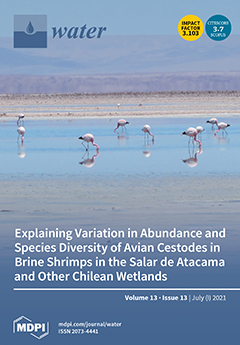The Wajid aquifer is considered the main source of water for drinking and irrigation in Wadi Al-Dawasir and Najran, the southern region of Saudi Arabia. This aquifer has been used since the 1960s, and due to the expansion in agricultural activities, the aquifer
[...] Read more.
The Wajid aquifer is considered the main source of water for drinking and irrigation in Wadi Al-Dawasir and Najran, the southern region of Saudi Arabia. This aquifer has been used since the 1960s, and due to the expansion in agricultural activities, the aquifer has been overexploited. The study aims to understand the origin, hydrochemical processes of the groundwater in the shallow unconfined, deep unconfined, and confined parts of the Wajid aquifer in the Wadi Al-Dawasir area. In-situ hydrochemical parameters (pH, temperature, EC, and TDS) were measured in the field, and groundwater samples were collected for major ions and stable isotopes (
2H and
18O) measurements in the laboratory. The results show that the groundwater in shallow unconfined, and confined aquifers are of two types; Cl.SO
4-Ca. Na and Cl.SO
4-Na. Ca; however, groundwater in deep, unconfined aquifers is characterized as HCO
3-Ca. Na, and Cl. HCO
3-Ca. Na; types of groundwater. The isotopic analysis results reveal that all groundwater samples have values of δ
18Oand δ
2Hclose to the local and global meteoric water lines, indicating the meteoric origin of Wajid groundwater. Three major hydrochemical processes, including rock weathering, ion exchange, and evaporation, have been identified as key controls on the chemical composition of water in the studied aquifer. The evaporation and ion exchange processes have more influence on the chemical composition of groundwater in the shallow unconfined and confined aquifers. On the contrary, weathering of carbonate minerals affected more the chemistry of groundwater in a deep unconfined aquifer. The unconfined section of the Wajid aquifer shows a reverse pattern of salinity with higher salinity in the recharge area, which is most probably related to the return irrigation water and leaching of salty soil. The open fractures in the upper part of Wajid sandstone most likely act as conduits to percolated saline water to the Wajid aquifer.
Full article





